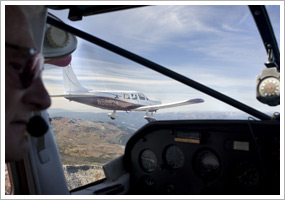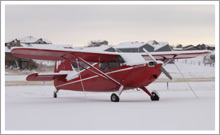Feb. 11, 2011 issue of 'AOPA ePilot: Flight Training Edition' newsletter
| ||||
| | FT News | INSIDE AOPA | TRAINING PRODUCTS | FINAL EXAM | |||
TRAINING TIPsIt’s still see and avoid Even in the age of airborne collision avoidance technology, extensive radar coverage, and eventually, the traffic reporting capabilities of automatic dependent surveillance-broadcast (ADS-B), the see-and-avoid doctrine remains the cornerstone of flying under visual conditions. The term may sound quaint, but see and avoid carries official weight. “The rules for maintaining separation from other aircraft during VFR operations are spelled out in FAR 91.113(b): ‘When weather conditions permit, regardless of whether an operation is conducted under instrument flight rules or visual flight rules, vigilance shall be maintained by each person operating an aircraft so as to see and avoid other aircraft,’” explains the Air Safety Institute’s Safety Advisor Collision Avoidance: Strategies and Tactics . You may know from ground school study that see and avoid means a lot more than just looking around. It calls on pilots to recognize known collision-risk areas such as operations in nontowered airport traffic patterns, and flight in the vicinity of VORs, where aircraft tracking inbound to the station tend to converge. It calls on pilots to be methodical in their technique of scanning for other traffic. Are you familiar with your aircraft’s blind spots? Every aircraft has them, as illustrated in this brief video. During your sessions practicing maneuvers, see and avoid means performing effective clearing turns. Here’s how. Being a safe see-and-avoid aviator means being aware that different pilots may use different methods for their arrivals and departures—an age-old topic for discussion reinvigorated by the January 2011 AOPA Pilot debate “Dogfight: Pattern Entry” between Editor at Large Tom Horne and Senior Editor Dave Hirschman. Everyone agrees that services like radar are a big help, but the pilot must interact with it correctly—a skill probed in this sample question from the Private Pilot Knowledge Test: “An ATC radar facility issues the following advisory to a pilot flying north in a calm wind: What was your answer? Is this traffic a potential conflict? Why was the wind condition part of the question? All to be discussed in the next installment. Until then, view the Air Safety Institute’s collision avoidance Webinar, “Look, Listen, and Live: Tips and Techniques for Avoiding Midair Mishaps,” for additional insights. YOUR PARTNER IN TRAININGWhether or not you believe in the mystical powers of the groundhog, weather decoding skills are a crucial part of your pilot training. AOPA’s online weather can help you to become more proficient in reading weather patterns, and you’ll become more confident in your ability to make a good go/no-go call. See also the many weather-related articles in the Flight Training archives as well those of our sister publication, AOPA Pilot —all of which are free to AOPA members, including those who receive six months of Flight Training free.
Did you know that student pilots who join AOPA are three times more likely to complete their flight training? Membership includes unlimited access to aviation information by phone (800/USA-AOPA, weekdays from 8:30 a.m. to 6 p.m. Eastern time) or from Flight Training Online or AOPA Online. If you're not already a member, join today and get the pilot’s edge. Login information is available online. FLIGHT TRAINING NEWSTry out the ‘Flight Training’ digital issueFlight Training is rolling out its very first digital issue. The new format contains all of the specialized training content you know and love, but comes packed with additional digital features such as videos, slideshows, polls, and more. You can download the March 2011 issue for reading offline, and the current version is compatible with most web browsers. View it now. If you like what you see, convert your Flight Training print edition to digital at no charge, or add it on for $10 per year. To make the change, go online. ATS takes delivery of Tecnam twinAirline Training Solutions of Jacksonville, Fla., recently took delivery of a Tecnam P2006T twin-engine aircraft. The school, which unveiled a new first officer training program in December, will use the Tecnam for flight training, while ground training will be conducted in Cessna Citations. Tecnams are manufactured in Italy and shipped to the United States for inspection and reassembly. ATS Program Director Hayden Malone helped Tecnam technicians to reassemble the airplane at Tecnam’s Richmond, Va., facility before he and ATS Chief Flight Instructor Scott Malone flew it to Florida. Test your weather knowledgeYou’ve read about weather in textbooks, but how well does the theory translate to the real world? Find out with the latest Air Safety Institute safety quiz, an assortment of questions meant to test the more practical side of your weather flying knowledge. Get started >> Fla. flight school helps Angel Flight transportAn Angel Flight medical mission received assistance from a Florida flight school while in the midst of transporting a transplant patient. The Angel Flight mission pilot was attempting to transport a patient in need of a lung transplant from Fort Lauderdale to Gainesville, and had to land at Kissimmee Gateway Airport because of a malfunctioning alternator. An instrument student and a CFII with SunState Aviation Flight School who had planned to fly a cross-country to Gainesville agreed to take the patient, amended their flight plan, and got her to her destination for surgery. This lady loves taildraggersJudy Birchler has loved tailwheel aircraft since she learned to fly an Aeronca Chief 38 years ago. She’s been on the lookout for other women who share her passion for taildraggers ever since, and more recently created the online community Ladies Love Taildraggers. Read more >> Remos owners invited to pre-Sun ’n Fun fly-inRemos Aircraft invites pilots of the light sport aircraft who are traveling to Sun ’n Fun to stop at Sebastian Municipal Airport on Florida’s east coast on their way to the show. Remos will host an owner’s open house at the airport on Monday, March 28, at its new national sales and marketing office next to LoPresti Aviation. The event will feature tours of the facility, discussions about aircraft maintenance, free time on a Remos flight training simulator, and a free lunch. Pilots who arrive in a Remos will be given a free fuel top-off to send them on their way to Lakeland. Remos owners are asked to RSVP by e-mail. Inside AOPABe your own valentine at the AOPA StoreShirts, jackets, hats, wallets, watches, books, DVDs, training materials—all that and much more is waiting for you at the AOPA Store. These products have been screened, tested, and approved by pilots to assure that the AOPA logo is placed only on the highest-quality merchandise. Every purchase you make will help to maintain the freedom, safety, and affordability of general aviation. Learn more >> Identity thieves are looking forward to your tax returnIdentity thieves are only too happy to use your stolen Social Security number to file a fraudulent tax return and receive refunds before you even file. How can you protect yourself? AOPA and LifeLock, the leader in proactive identity theft protection, offer you ways to protect yourself this tax season. Read more >> TRAINING PRODUCTSVFRmap.comThe recently launched VFRmap.com is a free online source of VFR and IFR charts and airport/facility directory data. Scroll around and zoom in or out on the charts. You also can choose five kinds of charts from a pulldown menu: hybrid VFR (a combination of world aeronautical charts, sectional, and terminal); VFR sectional; WAC; IFR en route high-altitude charts; and low IFR (a combination of IFR en route low-altitude charts and IFR area charts). You can’t draw a course on these charts, but the site is a quick and easy reference for a variety of uses. Note: Products listed have not been evaluated by ePilot editors unless otherwise noted. AOPA assumes no responsibility for products or services listed or for claims or actions by manufacturers or vendors. FINAL EXAMQuestion: Can panel-mounted VFR GPS and/or handheld GPS systems be used during IFR operations?
Answer: Yes, they can be used during IFR operations, but only as an aid to situational awareness. VFR GPS and/or handheld GPS systems are not approved for IFR navigation or instrument approaches. They should also not be used as a primary reference during instrument flight. Most VFR GPS receivers including all handheld units do not have receiver autonomous integrity monitoring, or RAIM, alerting capability. This means that a pilot might not be aware that the GPS signal had deteriorated to such point that a navigation error could occur. For more information on the use of both VFR and IFR GPS units, read the Air Safety Institute’s Safety Advisor, GPS from the Ground Up . Then test your knowledge with the institute’s GPS for VFR Operations and GPS for IFR Operations online courses.
Got a question for our technical services staff? E-mail [email protected] or call the Pilot Information Center, 800/872-2672. Don’t forget the online archive of “Final Exam” questions and answers, searchable by keyword or topic. What's New OnlineThis week the Flight Training blog has two installments for you: Jill W. Tallman discusses how challenging other pilots to a METAR/TAF-decoding contest can liven up those nasty winter days on the ground. Also, Chip Wright asks if you’ve ever had a situation where you had to add fuel to take on more passengers. It happens— but not in the GA world. AOPA Career OpportunitiesEver dream of turning your passion for aviation into a career? We’re looking for an aviation technical specialist, aviation education program developer, business analyst, financial analyst, IT project architect, program specialist—communications, and vice president of new product development and interactive marketing. To learn more about other AOPA career opportunities, visit AOPA Online. Picture Perfect
AVIATION EVENTS & WEATHER To include an event or to search all events in the calendar, visit AOPA Online. For airport details, including FBO fuel prices, see AOPA Airports. Flight Instructor Refresher ClinicsThe next Air Safety Institute Flight Instructor Refresher Clinics are scheduled in Melbourne, Fla., Nashua, N.H., and Las Vegas, Nev., Feb. 19 and 20; Oklahoma City, Okla., and Fort Worth, Texas, Feb. 26 and 27; Ontario, Calif., and Virginia Beach, Va., March 5 and 6; Phoenix, Ariz., Orlando, Fla., and Baltimore, Md., March 12 and 13; Burlingame, Calif., and King of Prussia, Pa., March 19 and 20. For a complete schedule, see AOPA Online.
Can’t make it in person? Sign up for the CFI Refresher Online. Air Safety Institute Safety SeminarsAir Safety Institute Safety Seminars are scheduled in Huntsville, Ala., Feb. 15; Decatur, Ga., Feb. 16; Greenville, S.C., Feb. 17; Northglenn, Colo., Feb. 21; Colorado Springs, Colo., Feb. 22; North Myrtle Beach, S.C., Feb. 23; Rochester, Minn., and Portland, Ore., March 7; Cedar Rapids, Iowa, and Seattle, Wash., March 8; Bellevue, Neb., March 9; Olathe, Kan., March 10; Ypsilanti, Mich., March 14; Cleveland, Ohio, March 15; Columbus, Ohio, March 16. Topics vary—for details and a complete schedule, see AOPA Online. | Advertisers Got news? Contact ePilot. Having difficulty using this service? Visit the ePilot Frequently Asked Questions now at AOPA Online or write to [email protected]. |
| Member Tools : Send feedback | ePilot Archive Editorial Team: ePilot Flight Training Editor : Jill W. Tallman | ePilot Editor: Sarah Brown | Contributor: Alton K. Marsh |

 Radar is reliable, and radios are reassuring, but watching out for conflicting traffic still mostly depends on another traffic-detection device in the cockpit: your eyes.
Radar is reliable, and radios are reassuring, but watching out for conflicting traffic still mostly depends on another traffic-detection device in the cockpit: your eyes.


